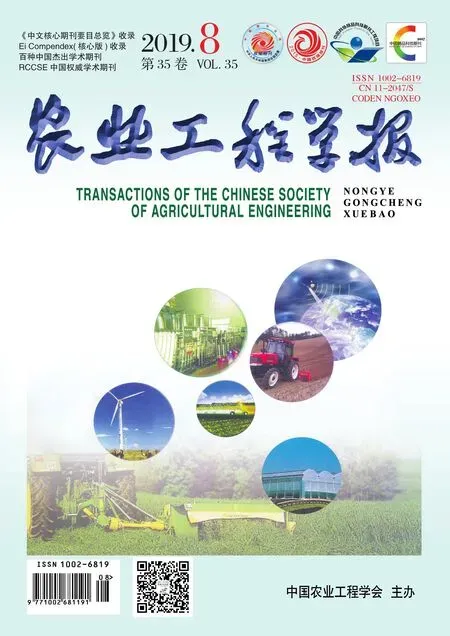西葫芦微咸水膜下滴灌土壤水盐运移对产量影响的预测模型
2019-05-24郭向红毕远杰孙西欢马娟娟孔晓燕
郭向红,毕远杰,孙西欢,3,马娟娟,孔晓燕
西葫芦微咸水膜下滴灌土壤水盐运移对产量影响的预测模型
郭向红1,毕远杰2,孙西欢1,3,马娟娟1,孔晓燕1
(1. 太原理工大学水利科学与工程学院,太原 030024; 2. 山西省水利水电科学研究院,太原 030002;3. 晋中学院,晋中 030619)
为了定量计算微咸水膜下滴灌对土壤水盐和西葫芦产量的影响,根据微咸水膜下滴灌土壤水盐运移特点和西葫芦生长试验,建立了西葫芦微咸水膜下滴灌土壤水盐运移模型和水盐生产函数,并将二者联立,建立了西葫芦微咸水膜下滴灌土壤水盐运移对产量影响的预测模型。利用西葫芦微咸水膜下滴灌水盐试验数据对模型进行验证,结果表明模型计算的西葫芦微咸水膜下滴灌土壤含水率和土壤含盐量与实测土壤含水率和土壤含盐量的变化趋势一致,模型计算土壤含水率、土壤含盐量和西葫芦产量的均方根误差分别为0.049 cm3/cm3、0.065 g/kg和3.83 t/hm2,土壤含水率、土壤含盐量和西葫芦产量的平均相对误差分别为5.17%、7.42%和5.84%,土壤含水率、土壤含盐量和西葫芦产量的平均绝对误差分别为0.047 cm3/cm3、0.062 g/kg和3.95 t/hm2。所建的模型具有较高的模拟精度,可用于模拟西葫芦微咸水膜下滴灌土壤水盐动态和西葫芦产量。
土壤;水;盐;产量;西葫芦;微咸水;膜下滴灌
0 引 言
随着中国社会和经济的发展,淡水资源短缺的问题日益突出,已成为制约中国农业可持续发展的瓶颈[1]。同时,中国浅层地下微咸水资源较为丰富,在北方平原地区储存着大量的微咸水资源[2]。滴灌是一种应用面积较广且非常节水的灌水方法,研究表明合理使用低浓度的微咸水进行灌溉,不会对作物造成明显减产,甚至会使产量有一定提高[3-10]。因此将微咸水和滴灌技术相结合,是解决中国农业缺水的有效途径之一。
微咸水灌溉在增加土壤水分的同时,也会增加土壤中的盐分,不合理的使用咸水灌溉会造成土壤质量下降,不利于作物出苗和生长,导致作物减产[11-13]。因此,合理使用微咸水灌溉,进行土壤水盐调控,对提高作物产量和保障土壤安全十分重要。随着计算机和数值计算方法的发展,数值模拟已成为研究土壤水盐运移的重要手段。针对每种灌水方法的水盐运移特点,栗现文[14]和黄金瓯[15]建立了棉田微咸水膜下滴灌土壤水盐运移模型,马海燕等[16]建立了微咸水膜孔沟灌土壤水盐运移模型,赵志强等[17]建立了冬小麦微咸水灌溉土壤水盐运移模型,Lila等[18]建立了微咸水地下滴灌土壤水盐运移模型。土壤水盐生产函数是反映土壤水盐与作物产量关系的数学模型,是制定微咸水灌溉最优灌溉制度的重要依据。王仰仁等[19]建立了棉花咸水灌溉土壤水盐生产函数,并在此基础上优化得到了棉花最优咸水灌溉制度。孔东等[20]对比不同向日葵水盐生产函数,发现Black模型比较适合内蒙古河套灌区向日葵产量模拟。王军涛等[21]在石羊河流域开展不同矿化度微咸水灌溉试验,构造了作物水盐响应模型。由此可见,只有结合具体的灌水方法、作物类型和气象条件建立的土壤水盐运移模型和水盐生产函数才具有实际应用价值。而且土壤水盐运移模型和土壤水盐生产函数二者是相互联系紧密结合的,土壤水盐运移模型可以为水盐生产函数提供输入(作物实际需水量和土壤含盐量),进而计算作物产量,所以将土壤水盐运移模型和水盐生产函数联立,建立土壤水盐运移对作物产量影响的预测模型十分必要。西葫芦是中国种植广泛和食用量较大的一种蔬菜,但针对微咸水灌溉对西葫芦生长影响的研究尚不多见。因此,本文进行微咸水膜下滴灌西葫芦生长试验,建立西葫芦微咸水膜下滴灌土壤水盐运移对产量影响的预测模型,为西葫芦微咸水高效安全灌溉提供支持。
1 材料与方法
1.1 试验区概况
试验于2016年在山西省水利水电科学研究院节水高效示范基地温室大棚内进行,该试验基地位于山西省太原市小店区(112°24′~112°43′E,37°36′~37°49′N),属于山西省晋中盆地。试验区属典型的暖温带季风影响下的大陆性半干旱气候类型,多年降水量468.4 mm左右,主要集中在6~9月,多年平均气温9.5 ℃,多年平均日照时数2 675.8 h,无霜期202 d。试验区土壤属于黏壤土,土壤机械组成及基本物理参数见表1。
表1 土壤机械组成
注:为土壤颗粒直径,mm。
Note:is soil particle diameter, mm.
试验基地有深浅2口机井,深井的井深180 m,浅井的井深80 m,浅水井为咸水井,地下水矿化度5.0 g/L,深水井为淡水井,地下水矿化度1.7 g/L。试验使用的微咸水是将这2种水按照特定的比例混合制成。
1.2 试验设计
试验在基地温室大棚内进行,分2部分,一是不同微咸水矿化度对膜下滴灌西葫芦生长试验(试验1);二是不同微咸水矿化度和土壤水分条件下膜下滴灌西葫芦生长试验(试验2)。试验1以微咸水矿化度为试验控制因子,即设1.7、3.5和5.0 g/L,共3个处理,每个处理3次重复。试验时,当土壤含水率下降到田间持水率(θ)的70%进行灌水,灌水上限控制在田间持水率(θ)的90%,试验设计与灌水方案见表2。
表2 试验1灌水次数与灌水定额
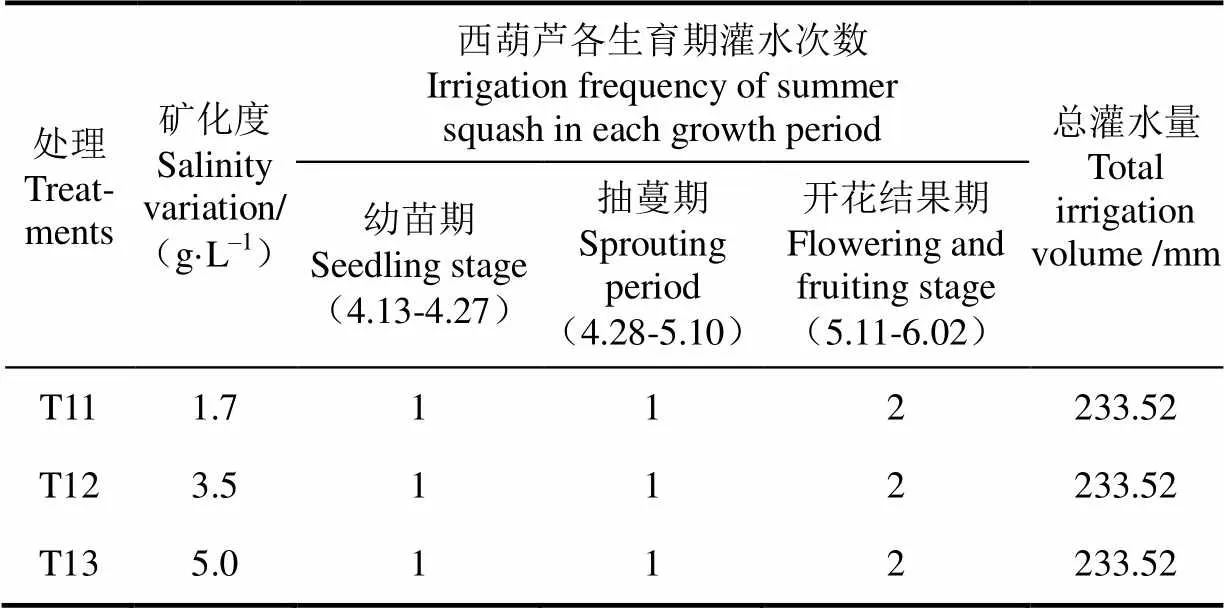
Tab.2 Irrigation times and irrigation amount in experiment 1
试验2是研究不同灌水水平和微咸水矿化度对膜下滴灌西葫芦生长的影响,试验设置了4个因素,其中3个土壤水分因素是在西葫芦的幼苗期、抽蔓期、开花结果期分别设置了3个灌水水平,土壤含水率分别控制在田间持水率的70%~90%、60%80%、50%~70%,第4个因素是灌水矿化度,设置3个水平,分别为1.7、3.5和5.0 g/L,采用正交试验设计,共9个处理(T21~T29),每个处理设置3次重复,试验设计方案见表3。
表3 试验2设计方案

Tab.3 Design scheme of experiment 2
西葫芦供试品种为夏比特,试验1于2016年4月2日播种,2016年6月2日收获,生育期共62 d,试验2于2016年8月2日播种,2016年10月5日收获,全生育期共65 d。膜下滴灌西葫芦种植模式为“一膜两管两行”,如图1所示。每行种植10株,株距0.6 m,行距0.6 m。滴头采用内镶式滴头,滴头间距0.3 m,滴头流量3 L/h。试验的每个处理种植在3个试验小区,每个试验小区包含2垄4行西葫芦,每垄长6 m,小区面积为14.4 m2。

图1 西葫芦微咸水膜下滴灌种植模式
1.3 测试项目
每隔5~7 d在地面垂直滴管带距滴头水平距离分别为0、10、20 cm处采用土钻采集土样,垂向采集间隔10 cm,深度50 cm。然后采用烘干法测定土壤含水率,使用上海仪电科学仪器股份有限公司的DDS-308电导率仪测定土壤含盐量。在西葫芦的各生育期,用毫米刻度尺测量西葫芦的叶片长度和叶片宽度,计算叶面积指数。进入结果期,每隔1~2 d用电子秤测量西葫芦产量。作物需水量采用水量平衡法计算[22]。采用自动气象站,记录温度、相对湿度、风速、气压、辐射等气象参数。
2 土壤水盐运移对产量影响的预测模型
2.1 控制方程
虽然水、肥、气、热、光、盐都对西葫芦的产量有影响,但在进行微咸水膜下滴灌时,其主要因素是水分和盐分。不同的土壤水分和盐分含量下会有不同的西葫芦产量,所以要建立微咸水膜下滴灌水盐运移与西葫芦产量模拟模型,就需要计算不同微咸水滴灌方案下土壤的水盐动态情况和不同土壤水盐动态对西葫芦产量的影响。而微咸水滴灌土壤水盐动态可以采用微咸水膜下滴灌土壤水盐运移模型计算[23],土壤水盐对西葫芦产量的影响可采用微咸水膜下滴灌西葫芦水盐生产函数计算[22]。假设滴灌点源条件下土壤水盐运移为轴对称,则水盐运移可简化为轴对称的二维问题来处理[24],计算区域如图2,并将微咸水膜下滴灌土壤水盐运移模型和西葫芦水盐生产函数联立,得到西葫芦微咸水膜下滴灌土壤水盐运移影响产量的预测模型,即:

注:A、B、C、D表示计算区域边界点;r为径向距离,cm;z为垂向距离,cm。



2.2 初始条件
土壤水分运动方程初始条件为

土壤盐分运移方程初始条件为

2.3 边界条件
2.3.1 水分运动边界条件
1)地表边界
当地表滴头下土壤水分没有饱和时

当滴头流量超过土壤入渗率时,在滴头下土壤表面便会形成一个半径R圆形饱和区域。若假定在地表饱和区域积水深度可忽略不计,则在饱和区有如下边界条件

式中R为饱和区域半径,cm,采用Gärdenäs等[25]提出的判别方法确定。
对于地表非饱和区,由于地表覆膜,故为隔水边界:

2)两侧边界AB和DC,考虑滴灌布置和水分运动的对称性,两侧边界均为零通量边界:

3)下边界,为自由出流边界条件,即

2.3.2 盐分运移边界条件
1)地表边界
当地表滴头下土壤水分没有饱和时,盐分运移为第三类边界:

式中C为灌溉水的盐分质量浓度,mg/cm3。
当滴头流量超过土壤入渗率时,在滴头下土壤表面便会形成一个圆形饱和区域,则在饱和区盐分边界为第一类边界,即

对于地表非饱和区,由于地表覆膜,隔盐边界:
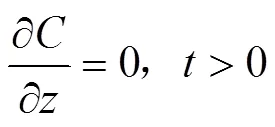
2)两侧边界和,考虑滴灌布置和水盐运移的对称性,两侧边界均为零通量边界:

3)下边界BC,为自由出流边界条件,即
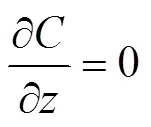
2.4 模型参数
2.4.1 土壤水分运动参数
土壤水分运动参数采用由美国学者van Genuchten于1980年提出的模型(以下简称VG模型)[26]


土壤水分运动参数根据机械组成采用RETC软件预测求得[27],见表4。

表4 土壤水分运动参数
2.4.2 土壤盐分运移参数




2.4.3 根系吸水模型与参数
根系吸水项可采用FEDDE提出的根系吸水模型[28]

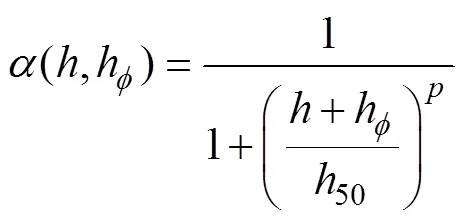

2.5 模型运行过程
膜下滴灌西葫芦土壤水盐运移影响产量的预测模型中的土壤水盐运移方程采用有限单元法离散,然后采用Visual Studio2017软件开发平台中的VB.NET语言编写计算程序,具体计算过程为:1)制定微咸水滴灌灌水方案,即确定微咸水西葫芦膜下滴灌每个生育期计划控制的含水率水平(灌水上限和下限)和所用灌溉水的矿化度。2)收集初始土壤剖面水分和盐分资料,以及西葫芦生长期温室大棚的气象资料。3)将初始资料代入微咸水膜下滴灌西葫芦土壤水盐运移模型,进行土壤水盐动态模拟,当土壤含水率低于设计的土壤含水率下限,便进行微咸水滴灌,当土壤水分到达上限便停止灌溉,依次进行便可以计算出土壤水盐的动态变化、根系吸水量、灌水次数和灌水量。4)对微咸水膜下滴灌西葫芦生育期土壤含盐量按生育期汇总,即可得到各生育期土壤含盐量。对西葫芦根系吸水量按生育期汇总,即可得到各生育阶段实际的蒸发蒸腾量。5)将各生育期土壤含盐量和各生育阶段实际的蒸发蒸腾量代入微咸水膜下滴灌西葫芦水盐生产函数,即可得到该微咸水灌水方案西葫芦的产量。
2.6 模型评价指标
模型的预测性能评价,采用平均绝对误差(mean absolute error, MAE)、平均相对误差(mean relative error, MRE)和均方根误差(root mean square error, RMSE)3个评价指标对模型进行评价,其计算公式分别为



式中V、V分别模型计算值和试验观测值;为观测点个数。
3 结果与分析
3.1 土壤水盐运移模型参数求解与验证
3.1.1 土壤水盐运移和根系吸水参数求解

表5 模型参数求解结果

Tab.5 Results of model parameter solution
3.1.2 土壤水盐运移模型验证
为了验证土壤水盐运移模型的正确性,采用微咸水矿化度为5.0 g/L的膜下滴灌西葫芦实测土壤水盐数据,对微咸水膜下滴灌土壤水盐模型进行验证。
1)土壤含水率实测值与模拟值对比
选取微咸水矿化度为5.0 g/L的膜下滴灌西葫芦3次实测土壤水盐剖面分布数据对模型进行验证,即2016年4月18日、5月24日和6月2日。图3为实测微咸水膜下滴灌土壤含水率与模拟土壤含水率分布对比图,=0、10、20 cm表示距滴头的水平距离。由图3可以看出,4月18日和6月2日,实测土壤含水率和模拟土壤含水率均是表层土壤含水率较小,随着深度增大土壤含水率增大,这是因为4月18日和6月2日均为灌后10 d,在西葫芦根系吸水和水分再分布共同作用导致。5月24日实测土壤含水率和模拟土壤含水率均是表层土壤含水率最大,随着深度增大土壤含水率降低,这是因为5月24日为灌后1 d所致。同时,采用SPSS20对土壤含水率模拟值与实测值进行相关性分析,相关性如图4a所示,土壤含水率的计算值与实测值的相关性方程斜率为0.999 2,决定系数为0.902 9,在0.01水平下显著相关。并进一步计算得到模型模拟土壤含水率的均方根误差为0.049 cm3/cm3,平均相对误差为5.17%,平均绝对误差为0.047 cm3/cm3。由此可见,本研究建立的微咸水膜下滴灌西葫芦土壤水盐模型计算土壤含水率和实测含水率之间具有较好的吻合性,精度较高,能够模拟田间水分运动趋势。

注:r为距滴头的水平距离,cm。下同。
2)土壤盐分实测值与模拟值对比
图5为2016年4月18日、5月24日和6月2日的实测微咸水膜下滴灌土壤含盐量与模拟土壤含盐量分布对比图。由图5可以看出,模拟土壤含盐量与实测土壤含盐量吻合较好,4月18日和6月2日,实测土壤含盐量和模拟土壤含盐量均是表层土壤含盐量最大,土壤含盐量随着土壤深度增大而降低,这是因为4月18日和6月2日均为灌后10 d,在西葫芦根系吸水和水分再分布共同作用下,水分上移,导致表层积盐。5月24日实测土壤含盐量和模拟土壤含盐量均是表层土壤含盐量最小,随着深度增大土壤含盐量增大,这是因为5月24日为灌后1 d,盐分在水分的淋洗下聚集在湿润锋附近所致。采用SPSS20对土壤含盐量模拟值与实测值进行相关性分析,如图4b所示,土壤含盐量的计算值与实测值的相关性方程斜率为0.998 6,决定系数为0.902 7,在0.01水平下显著相关。进一步计算得到模型模拟土壤含盐量的均方根误差为0.065 g/kg,平均相对误差为7.42%,平均绝对误差为0.062 g/kg。由此可见,本研究建立的微咸水膜下滴灌西葫芦土壤水盐模型具有良好的模拟性能,能够模拟田间土壤盐分运移的趋势。

图4 水盐运移模型模拟值与实测值相关性分析

图5 不同剖面土壤含盐量模拟值与实测值对比
3.2 西葫芦膜下滴灌水盐生产函数参数求解与分析
根据试验2的9组试验数据,利用最小二乘法求解得到西葫芦水分敏感指数和盐分敏感指数,见表6。
表6 西葫芦水分敏感指数和盐分敏感指数

Tab.6 Water sensitivity index and salt sensitivity index of summer squash
水分敏感指数表示西葫芦产量对缺水的敏感程度,越大表示越敏感,缺水后减产越严重。由表6可知,西葫芦不同生育阶段水分敏感指数从大到小依次是:开花结果期、抽蔓期、幼苗期。由此可见,在水资源有限情况下,为了使西葫芦产量最高,需要优先保障西葫芦开花结果期需水,可适当在幼苗期进行水分胁迫,这与翟胜等[33]的研究结果类似。盐分敏感指数表示西葫芦产量对土壤盐分的敏感程度,越大表示越敏感,盐分胁迫后减产越严重。由表6可知,西葫芦不同生育阶段盐分敏感指数从大到小依次是:幼苗期、抽蔓期、开花结果期。这说明随着生育期的推移,西葫芦不断生长,耐盐性逐渐增强,在水资源短缺地区,可以在西葫芦生长后期采用微咸水灌溉。
3.3 西葫芦膜下滴灌产量预测模型验证与分析
为了进一步验证构建的微咸水膜下滴灌西葫芦产量模拟模型的可行性和正确性,利用试验2的9个处理的试验资料对其进行验证。将不同处理的土壤初始水盐资料和微咸水灌水方案代入微咸水膜下滴灌西葫芦水盐运移与产量模拟模型,即可求出不同处理下西葫芦的产量。图6为西葫芦产量模型计算值与实测值对比图,由图可知,各处理的模型计算西葫芦产量和实测西葫芦产量趋势一致。进一步计算模型产量模拟的均方根误差RMSE为3.83 t/hm2,平均相对误差为5.84%,平均绝对误差为3.95 t/hm2。说明本研究所建立的微咸水膜下滴灌西葫芦水盐运移对产量影响的预测模型对西葫芦产量具有较好的预测能力,可以用于微咸水膜下滴灌西葫芦产量的模拟计算。
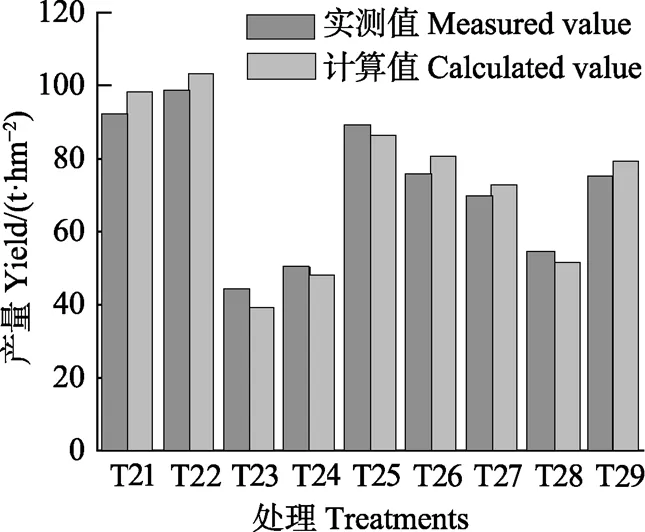
注:处理条件见表3。
表7为试验2西葫芦微咸水滴灌水盐试验采用极差法分析的因素效应表。根据表7中每个因素西葫芦产量的极差可知,对西葫芦的产量影响从大到小为微咸水矿化度、抽蔓期、幼苗期和开花结果期。同时,根据表中各因素的水平均值可知,西葫芦微咸水膜下滴灌的最优方案为:幼苗期的土壤含水率控制在田间持水率的70%~90%、抽蔓期的土壤含水率控制在田间持水率的60%~80%、开花结果期的土壤含水率控制在田间持水率的60%~80%,微咸水矿化度为1.7 g/L。采用微咸水矿化度为3.5 g/L灌溉,虽然产量会减低,但减少幅度不大,相对于1.7 g/L产量仅减少4.75%,因此在淡水资源非常紧缺的地区也可采用矿化度为3.5 g/L对微咸水进行灌溉。
表7 因素效应表

Tab.7 Factor effect table
4 结 论
1)根据西葫芦微咸水膜下滴灌生长特点,将微咸水膜下滴灌土壤水盐运移模型和西葫芦水盐生产函数联立,建立了微咸水膜下滴灌西葫芦水盐运移对产量影响的预测模型,该模型不但可以模拟田间水盐动态,而且可以进行微咸水膜下滴灌西葫芦的产量。
2)根据田间试验资料,对模型进行验证,结果表明模型计算的西葫芦微咸水膜下滴灌土壤含水率和土壤含盐量与实测土壤含水率和土壤含盐量的变化趋势一致,模型计算土壤含水率、土壤含盐量和西葫芦产量的均方根误差分别为0.049 cm3/cm3、0.065 g/kg和3.83 t/hm2,土壤含水率、土壤含盐量和西葫芦产量的平均相对误差分别为5.17%、7.42%和5.84%,土壤含水率、土壤含盐量和西葫芦产量的平均绝对误差分别为0.047 cm3/cm3、0.062 g/kg和3.95 t/hm2,模型具有较高的模拟精度,可以用于西葫芦微咸水膜下滴灌水盐运移与产量预测。
3)采用极差法得到了西葫芦微咸水膜下滴灌的最优方案为:幼苗期的土壤含水率控制在田间持水率的70%~90%、抽蔓期的土壤含水率控制在田间持水率的60%~80%、开花结果期的土壤含水率控制在田间持水率的60%~80%,微咸水矿化度为1.7 g/L,在淡水资源非常紧缺的地区也可采用矿化度为3.5 g/L的微咸水进行灌溉。
[1] 虞祎,张晖,胡浩. 农业生产与水资源承载力评价[J]. 中国生态农业学报,2016,24(7):978-986. Yu Yi, Zhang Hui, Hu Hao. Agricultural production and evaluation in terms of water resources carrying capacity[J]. Chinese Journal of Eco-Agriculture, 2016, 24(7): 978-986. (in Chinese with English abstract)
[2] 叶海燕. 微咸水利用试验研究[D]. 西安:西安理工大学,2004. Ye Haiyan. Experimental Studies on Saline Water Utilization[D]. Xi’an: Xi’an University of Technology, 2004. (in Chinese with English abstract)
[3] 毕远杰,王全九,雪静. 微咸水造墒对油葵生长及土壤盐分分布的影响[J]. 农业工程学报,2009,25(7):39-44. Bi Yuanjie, Wang Quanjiu, Xue Jing. Effect of saline water for increasing soil water before sowing on helianthus growth and saline distributional characteristics of soil[J]. Transactions of the Chinese Society of Agricultural Engineering (Transactions of the CSAE), 2009, 25(7): 39-44. (in Chinese with English abstract)
[4] 王全九,王文焰,汪志荣,等. 盐碱地膜下滴灌技术参数的确定[J]. 农业工程学报,2001,17(2):47-50. Wang Quanjiu, Wang Wenyan, Wang Zhirong, et al. Determination of technique parameters for saline-alkali soil through drip irrigation under film[J]. Transactions of the Chinese Society of Agricultural Engineering (Transactions of the CSAE), 2001, 17(2): 47-50. (in Chinese with English abstract)
[5] 何子建,史文娟,杨军强. 膜下滴灌间作盐生植物棉田水盐运移特征及脱盐效果[J]. 农业工程学报,2017,33(23):129-138. He Zijian, Shi Wenjuan, Yang Junqiang. Water and salt transport and desalination effect of halophytes intercropped cotton field with drip irrigation under film[J]. Transactions of the Chinese Society of Agricultural Engineering (Transactions of the CSAE), 2017, 33(23): 129-138. (in Chinese with English abstract)
[6] 谭军利,康跃虎,焦艳平,等. 不同种植年限覆膜滴灌盐碱地土壤盐分离子分布特征[J]. 农业工程学报,2008,24(6):59-63. Tan Junli, Kang Yuehu, Jiao Yanping, et al. Characteristics of soil salinity and salt ions distribution in salt-affected field under mulch-drip irrigation in different planting years[J]. Transactions of the Chinese Society of Agricultural Engineering (Transactions of the CSAE), 2008, 24(6): 59-63. (in Chinese with English abstract)
[7] 王诗景,黄冠华,杨建国,等. 微咸水灌溉对土壤水盐动态与春小麦产量的影响[J]. 农业工程学报,2010,26(5):27-33. Wang Shijing, Huang Guanhua, Yang Jianguo, et al. Effect of irrigation with saline water on water-salt dynamic and spring wheat yield[J]. Transactions of the Chinese Society of Agricultural Engineering (Transactions of the CSAE), 2010, 26(5): 27-33. (in Chinese with English abstract)
[8] 万书勤,康跃虎,王丹,等. 华北半湿润地区微咸水滴灌对番茄生长和产量的影响[J]. 农业工程学报,2008,24(8):30-35. Wan Shuqin, Kang Yuehu, Wang Dan, et al. Effect of saline water on tomato growth and yield by drip irrigation in semi- humid regions of north China[J]. Transactions of the Chinese Society of Agricultural Engineering (Transactions of the CSAE), 2008, 24(8): 30-35. (in Chinese with English abstract)
[9] 吴忠东,王全九. 微咸水非充分灌溉对土壤水盐分布与冬小麦产量的影响[J]. 农业工程学报,2009,25(9):36-42. Wu Zhongdong, Wang Quanjiu. Effects of deficit irrigation with brackish water on soil water-salt distribution and winter wheat yield[J]. Transactions of the Chinese Society of Agricultural Engineering (Transactions of the CSAE), 2009, 25(9): 36-42. (in Chinese with English abstract)
[10] 张俊鹏,曹彩云,冯棣,等. 微咸水造墒条件下植棉方式对产量与土壤水盐的影响[J]. 农业机械学报,2013,44(2):97-102.Zhang Junpeng, Cao Caiyun, Feng Di, et al. Effects of different planting patterns on cotton yield and soil water-salt under brackish water irrigation before sowing[J]. Transactions of the Chinese Society for Agricultural Machinery, 2013, 44(2): 97-102. (in Chinese with English abstract)
[11] Pasternak. Irrigation with brackish water under desert conditions XI. Salt tolerance in sweet-corn cultivars[J]. Agricultural Water Management, 1995, 28(4): 325-334.
[12] Amnon B, Shabtai C, Yoel D M, et al. Effects of timing and duration of brackish irrigation water on fruit yield and quality of late summer melons[J]. Agricultural Water Management, 2005, 74(2): 123-134.
[13] 张展羽,郭相平. 微咸水灌溉对苗期玉米生长和生理性状的影响[J]. 灌溉排水学报,1999, 18(1):18-22. Zhang Zhanyu, Guo Xiangping. Effects of NaCl on growth and physiological processes of maize seedlings[J]. Journal of Irrigation &Drainage, 1999, 18(1): 18-22. (in Chinese with English abstract)
[14] 栗现文. 干旱区微咸水膜下滴灌棉田土壤水流系统及其应用[D]. 武汉:中国地质大学,2014. Li Xianwen. Soil Water Flow System of Mulched Drip Irrigation with Brackish Water and its Application in an Arid Region[D]. Wuhan: China University of Geosciences, 2014. (in Chinese with English abstract)
[15] 黄金瓯. 旱区微咸水膜下滴灌水—土—棉花系统溶质时空变化规律及其应用[D]. 武汉:中国地质大学,2016. Huang Jinou. Spatial-temporal Evolution Of Solutes In Water-Soil-Cotton Ecosystem Under Mulched Drip Irrigation With Brackish Water And Its Application In An Arid Region[D]. Wuhan: China University of Geosciences, 2016. (in Chinese with English abstract)
[16] 马海燕,王昕,张展羽,等. 基于HYDRUS-3D的微咸水膜孔沟灌水盐分布数值模拟[J]. 农业机械学报,2015,46(2):137-145. Ma Haiyan, Wang Xin, Zhang Zhanyu, et al. Numerical simulation of water-salt distribution under brackish water film hole furrow irrigation based on HYDRUS—3D model[J]. Transactions of the Chinese Society for Agricultural Machinery, 2015, 46(2): 137-145. (in Chinese with English abstract)
[17] 赵志强,徐征和,闫良国,等. 惠民县微咸水灌溉区土壤水盐运移数值模拟及分析[J]. 灌溉排水学报,2017,36(1):33-39. Zhao Zhiqiang, Xu Zhenghe, Yan Liangguo, et al. Numerical simulation and analysis of the transport of soil water and salt in brackish water irrigation area of huimin[J]. Journal of Irrigation & Drainage, 2017, 36(1): 33-39. (in Chinese with English abstract)
[18] Lila T S A, Berndtsson R, Persson M, et al. Numerical evaluation of subsurface trickle irrigation with brackish water[J]. Irrigation Science, 2013, 31(5): 1125-1137.
[19] 王仰仁,康绍忠. 基于作物水盐生产函数的咸水灌溉制度确定方法[J]. 水利学报,2004,35(6):46-51. Wang Yangren, Kang Shaozhong. Saline water irrigation scheduling method based on crop-salt-water production function[J]. Journal of Hydraulic Engineering, 2004, 35(6): 46-51. (in Chinese with English abstract)
[20] 孔东. 含盐土壤节水灌溉下作物—水—盐响应关系及模型研究[D]. 呼和浩特:内蒙古农业大学,2004. Kong Dong. Study on Crop Response to Soil Water-salt and its Modelling for Saline Soil under Water-saving Irrigation [D]. Hohhot: Inner Mongolia Agricultural University, 2004. (in Chinese with English abstract)
[21] 王军涛,程献国,李强坤. 基于春玉米微咸水灌溉的水盐生产函数研究[J]. 干旱地区农业研究,2012,30(3):78-80.Wang Juntao, Cheng Xianguo, Li Qiangkun. Study on water-salt production function based on saline water irrigation for spring corn[J]. Agricultural Research in the Arid Areas, 2012, 30(3): 78-80. (in Chinese with English abstract)
[22] 孔晓燕. 微咸水膜下滴灌对西葫芦生长影响及水盐生产函数研究[D]. 太原:太原理工大学,2017. Kong Xiaoyan. Studies on the Effects of Summer Squash Growth and Water-salt Production Function under Mulched Drip-irrigation with Brackish Water [D]. Taiyuan: Taiyuan University of Technology, 2017. (in Chinese with English abstract)
[23] Qi Zhijuan, Feng Hao, Zhao Ying, et al. Spatial distribution and simulation of soil moisture and salinity under mulched drip irrigation combined with tillage in an arid saline irrigation district, northwest China[J]. Agricultural Water Management, 2018, 201: 219-231.
[24] Zhou Qingyun, Kang Shaozhong, Zhang Lu, et al. Comparison of APRI and Hydrus-2D models to simulate soil water dynamics in a vineyard under alternate partial root zone drip irrigation [J]. Plant and Soil, 2007, 291(1/2): 211-223.
[25] Gärdenäs A I, Hopmans J W, Hanson B R, et al. Two- dimensional modeling of nitrate leaching for various fertigation scenarios under micro-irrigation[J]. Agricultural Water Management, 2005, 74(3): 219-242.
[26] Van Genuchten M T. A closed-form equation for predicting the hydraulic conductivity of unsaturated soil[J]. Soil Sci. Soc. Am. J., 1980, 44(5): 892-898.
[27] Van Genuchten M, Leij F, Yates S. The RETC code for quantifying the hydraulic functions of unsaturated soils [R]. Oklahoma: US Environmental Protection Agency, 1991.
[28] Feddes R A, Bresler A E, Neuman S P. Field test of a modified numerical model for water uptake by root system[J]. Water Resources Res, 1974, 10(6): 1199-1206.
[29] Allen R G, Pereira L S, Raes D, et al. Crop evapotranspiration guidelines for computing crop water requirements[C]//. Irrigation and Drainage Paper No.56, FAO, Rome, 1998.
[30] Van Genuchten M T. A numerical model for water and solute movement in and below the root zone[C]//. Research Report No 121, U.S. Salinity laboratory, USDA, ARS, Riverside, California, 1987.
[31] Vrugt J A, Hopmans J W, Šimunek J. Calibration of a two- dimensional root water uptake model[J]. Fluid Phase Equilibria, 2001, 65(65): 1027-1037.
[32] 郭向红,孙西欢,马娟娟,等. 基于混合遗传算法和积水入渗实验反求土壤水力参数[J]. 应用基础与工程科学学报,2010,18(6):1017-1026. Guo Xianghong, Sun Xihuan, Ma Juanjuan, et al. Inverse model estimating soil hydraulic parameters based on hybrid genetic algorithms and ponding infiltration experiment[J]. Journal of Basic Science and Engineering, 2010, 18(6): 1017-1026. (in Chinese with English abstract)
[33] 翟胜,梁银丽,王巨媛,等. 干旱半干旱地区日光温室黄瓜水分生产函数的研究[J]. 农业工程学报,2005,21(4): 136-139. Zhai Sheng, Liang Yinli, Wang Juyuan, et al. Water production function of cucumber in Chinese solar greenhouse in arid and semiarid region[J]. Transactions of the Chinese Society of Agricultural Engineering (Transactions of the CSAE), 2005, 21(4): 136-139(in Chinese with English abstract)
Prediction model of soil water and salt transport on yield of summer squash under mulch drip irrigation with brackish water
Guo Xianghong1, Bi Yuanjie2, Sun Xihuan1,3, Ma Juanjuan1, Kong Xiaoyan1
(1.030024,; 2.030002,; 3.030619,)
Water resources are very scarce in northern China. In order to improve the utilization efficiency of brackish water and agricultural water resources, Mulch drip irrigation with brackish water has been widely studied. Mulch drip irrigation with brackish water is a highly efficient irrigation technology that combines brackish water and mulch drip irrigation, which not only saves water but also makes full use of brackish water resources. In order to quantitatively calculate the effects of mulch drip irrigation with brackish water on soil water salt and summer squash yield, the water salt transport model and water salt production function of mulch drip irrigation with brackish water were established according to the characteristics of soil water-salt transport under mulch drip irrigation with brackish and summer squash growth experiment. A prediction simulation model of soil water-salt transport and yield was established by combining the two models under mulch drip irrigation with brackish water. In order to verify the model, experiments with two groups of summer squash under mulch drip irrigation with brackish water were carried out. The first group was the growth experiment of summer squash under mulch drip irrigation with different salinity of brackish water (1.7, 3.5, 5.0 g/L). The second experiment was to study the effects of different irrigation levels and different salinity of brackish water on the growth of summer squash under mulch drip irrigation. Three irrigation levels were set at seedling stage, vine-pumping stage and flowering and fruiting stage, namely 70%-90%of field water holding capacity, 60%-80%of field water holding capacity, 50%-70% of field water holding capacity, respectively. The three levels of irrigation salinity were 1.7 g/L, 3.5 g/L and 5.0 g/L, respectively. A total of nine treatments were designed by orthogonal experiment. The results showed that the soil water content, soil salt content and yield of the summer squash calculated by the model was in agreement with the trend of the measured soil water content, soil salt content and yield of the summer squash under mulch drip irrigation with brackish water. The root mean square error of the soil water content, soil salt content and yield of the summer squash calculated by the model was 0.049 cm3/cm3, 0.065 g/kg and 3.83 t/hm2, respectively. The average relative error of the soil water content, soil salt content and yield of the summer squash calculated by the model was respectively 5.17%, 7.42% and 5.84%, and the average absolute error of the soil water content, soil salt content and yield of the summer squash calculated by the model was respectively 0.047 cm3/cm3, 0.062 g/kg and 3.95 t/hm2. Therefore, the model had higher simulation accuracy and can be used to simulate the distribution and dynamic changes of soil water-salt and yield of summer squash under mulch drip irrigation with brackish water. The optimum scheme of drip irrigation under film with brackish water for summer squash was obtained by range method. The soil water content at seedling stage was controlled at 70%-90% of field water holding capacity, at sprouting stage was controlled at 60% - 80%of field water holding capacity, at flowering and fruiting stage was controlled at 60% - 80% of field water holding capacity, and the salinity of brackish water was 1.7 g/L. However, brackish water with salinity of 3.5 g/L can also be used for irrigation in areas where freshwater resources are very scarce.
soils; water; salt; yield; summer squash; brackish water; mulch drip irrigation
2018-07-12
2019-03-18
国家自然科学基金项目(51209131)和山西省自然科学基金项目(201601D011053)
郭向红,教授,主要从事节水灌溉理论与技术研究,Email:xianghong7920@126.com
10.11975/j.issn.1002-6819.2019.08.020
S152.7
A
1002-6819(2019)-08-0167-09
郭向红,毕远杰,孙西欢,马娟娟,孔晓燕.西葫芦微咸水膜下滴灌土壤水盐运移对产量影响的预测模型[J]. 农业工程学报,2019,35(8):167-175. doi:10.11975/j.issn.1002-6819.2019.08.020 http://www.tcsae.org
Guo Xianghong, Bi Yuanjie, Sun Xihuan, Ma Juanjuan, Kong Xiaoyan.Prediction model of soil water and salt transport on yield of summer squash under mulch drip irrigation with brackish water[J]. Transactions of the Chinese Society of Agricultural Engineering (Transactions of the CSAE), 2019, 35(8): 167-175. (in Chinese with English abstract) doi:10.11975/j.issn.1002-6819.2019.08.020 http://www.tcsae.org
